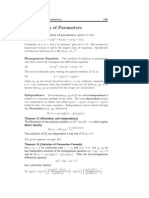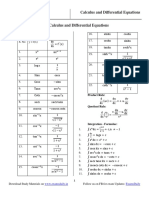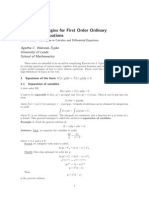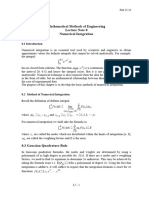Variation of Parameters
Uploaded by
MatthewVariation of Parameters
Uploaded by
MatthewVariation of Parameters
If the functions P, Q, and f are continuous on an open interval I, and if the functions y1 and y2 are linearly independent solutions of the homogeneous equation corresponding to the nonhomogeneous equation, y + P(x)y + Q(x)y = f (x) then a particular solution of equation(1) is y2 (x)f (x) dx + y2 (x) W (y1 , y2 )(x) and the general solution is yp = y1 (x) y = c1 y1 (x) + c2 y2 (x) +yp yh Will always give a particular solution yp provided that that the associated homogeneous equation can be solved. No restriction on f (x), however the integrals may not always be evaluated by elementary analytical methods, however they can usually be calculated by using Trapezoidal rule or some other numerical techniques. This method can be generalized for higher-order dierential equations.
MSW MTH 291
(1)
y1 (x)f (x) dx W (y1 , y2 )(x)
(2)
(3)
You might also like
- 5.4 Variation of Parameters: Homogeneous EquationNo ratings yet5.4 Variation of Parameters: Homogeneous Equation6 pages
- Engineering Mathematics Term Paper ReviewNo ratings yetEngineering Mathematics Term Paper Review18 pages
- Nonhomogeneous Second Order Linear OdesNo ratings yetNonhomogeneous Second Order Linear Odes12 pages
- Differential Equations - MTH401 Handouts Lecture 20No ratings yetDifferential Equations - MTH401 Handouts Lecture 2011 pages
- Analytic Functions Necessary and Sufficient Condition: Cauchy-Riemann EquationsNo ratings yetAnalytic Functions Necessary and Sufficient Condition: Cauchy-Riemann Equations58 pages
- Variation of Parameters Method For Higher-Order Equations: Dy D y Dy A A A Ay DX DX DX100% (1)Variation of Parameters Method For Higher-Order Equations: Dy D y Dy A A A Ay DX DX DX18 pages
- WEEK 7 3 5 Variation of Parameters To Find A Particular Solution 3 6 Cauchy Euler Differential Equations100% (1)WEEK 7 3 5 Variation of Parameters To Find A Particular Solution 3 6 Cauchy Euler Differential Equations19 pages
- Unit 3 - Lecture 1- Introduction Numerical Integration by Trapezoidal RuleNo ratings yetUnit 3 - Lecture 1- Introduction Numerical Integration by Trapezoidal Rule15 pages
- Variation of Parameters For Second Order PDFNo ratings yetVariation of Parameters For Second Order PDF2 pages
- Pythagorean - Theano.de Fileadmin User Upload 1951 1storderDiffEQnotesNo ratings yetPythagorean - Theano.de Fileadmin User Upload 1951 1storderDiffEQnotes9 pages
- Unit2 Multivar Calculus With CorrectionNo ratings yetUnit2 Multivar Calculus With Correction64 pages
- L5 Emt 2101 Engineering Mathematics IiiNo ratings yetL5 Emt 2101 Engineering Mathematics Iii15 pages
- Numerical Differentiation and IntegrationNo ratings yetNumerical Differentiation and Integration12 pages
- MATH 38: Mathematical Analysis III: Unit 3: Differentiation of Functions of More Than One VariableNo ratings yetMATH 38: Mathematical Analysis III: Unit 3: Differentiation of Functions of More Than One Variable76 pages
- Numerical Methods: Unit - Iv Numerical DifferentiationNo ratings yetNumerical Methods: Unit - Iv Numerical Differentiation23 pages
- Partial Differentiation - GATE Study Material in PDFNo ratings yetPartial Differentiation - GATE Study Material in PDF8 pages
- Method of Undetermined Coefficients, Variation of Parameters, SuperpositionNo ratings yetMethod of Undetermined Coefficients, Variation of Parameters, Superposition16 pages
- Mathematics 1St First Order Linear Differential Equations 2Nd Second Order Linear Differential Equations Laplace Fourier Bessel MathematicsFrom EverandMathematics 1St First Order Linear Differential Equations 2Nd Second Order Linear Differential Equations Laplace Fourier Bessel MathematicsNo ratings yet
- Hyperbolic and Inverse Integral and Derivative FormulasNo ratings yetHyperbolic and Inverse Integral and Derivative Formulas2 pages
- Least Common Multiple of Algebraic Expressions100% (1)Least Common Multiple of Algebraic Expressions1 page







































































